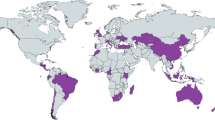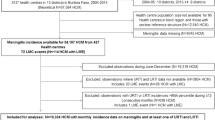Abstract
Both influenza and meningococcal disease (MD) show seasonal variation with peak incidence rates during the winter. We examined whether fluctuations in occurrence of influenza were associated with changes in the incidence rate of MD, either simultaneously or with a delay of one or 2 weeks, and whether age had an impact on these associations. This ecological study was based on weekly surveillance data on influenza and a complete registration of MD cases (n = 413) in North Jutland County, Denmark, during 1980–1999. A total of 379 MD cases occurred during weeks with influenza registration. The analysis was done using a Poisson regression model taking into account the seasonal variation and trend over time in incidence rate of MD, and stratified by age: <1 year (n = 38), 1–14 years (n = 189), and ≥ 14 years (n = 152). An increase of 100 registered cases of influenza per 100,000 inhabitants was associated with a 7% (95% CI: −1 to 15%) increase in the number of MD cases during the same week. The association was most marked for <1 year-olds, corresponding to a 29% (95% CI: 6–58%) increase in the number of MD cases per 100 cases of influenza per 100,000 inhabitants. Our findings support the theory that the influenza detection rate is associated with the number of MD cases in the population during the same week.
Similar content being viewed by others
References
Connolly M, Noah ND. Is group C meningococcal disease increasing in Europe? A report of surveillance of meningococcal infection in Europe 1993–1996. Epidemiol Infect 1999; 122: 41–49.
Stuart JM, Robinson PM, Cartwright K, Noah ND. Antibiotic prescribing during an outbreak of meningococcal disease. Epidemiol Infect 1996; 117: 103–105.
Cartwright K, Jones DM, Smith AJ, Stuart JM, Kaczmarski EB, Palmer SR. Influenza A and meningococcal disease. Lancet 1991; 338: 554–557.
Hubert B, Watier L, Garnerin P, Richardson S. Meningococcal disease and influenza-like syndrome: A new approach to an old question. J Infect Dis 1992; 166: 542–545.
Cartwright K. Meningococcal carriage and disease. In: Cartwright K (ed), Meningococcal disease, Chichester, UK: John Wiley & Sons, 1995; 115–146.
Sim RJ, Harrison MM, Moxon ER, Tang CM. Underestimation of meningococci in tonsillar tissue by nasopharyngeal swabbing. Lancet 2000; 356: 1653–1654.
Hope-Simpson RE. The role of season in the epidemiology of influenza. J Hyg Camb 1981; 86: 35–47.
Wachmann CH. Uses of epidemic and statistical models in the surveillance of infectious diseases. [PhD Dissertation]. University of Copenhagen: Biostatistical Department, Statens Serum Institut, 1997.
Monto AS, Sullivan KM. Acute respiratory illness in the community. Frequency of illness and the agents involved. Epidemiol Infect 1993; 110: 145–160.
Fleming DM, Zambon M, Bartelds AI. Population estimates of persons presenting to general practitioners with influenza-like illness, 1987–1996: A study of the demography of influenza-like illness in sentinel practice networks in England and Wales, and in The Netherlands. Epidemiol Infect 2000; 124: 245–253.
Jensen ES, Lundbye-Christensen S, Pedersen L, Sørensen HT, Schønheyder HC. Seasonal variation in meningococcal disease in Denmark: Relation to age and meningococcal phenotype. Scand J Infect Dis 2003; 35: 226–229.
Jensen ES, Schønheyder HC, Lind I, Berthelsen L, Nørgård B, Sørensen HT. Neisseria meningitidis phenotypic markers and septicaemia, disease progress and case-fatality rate of meningococcal disease: A 20-year population-based historical follow-up study in a Danish county. J Med Microbiol 2003; 52: 173–179.
McCullagh P, Nelder JA. Generalized linear models. 2nd edn. London: Chapman and Hall, 1989.
Sørensen HT, Hansen I, Ejlersen E, Schønheyder HC, Hamburger H, Sabroe S. Identification of cases of meningococcal disease: Data quality in two Danish population-based information systems during a 14-year period. Int J Risk Saf Med 1995; 7: 179–189.
Carrat F, Tachet A, Rouzioux C, Housset B, Valleron A-J. Evaluation of clinical case definitions of influenza: Detailed investigation of patients during the 1995–1996 epidemic in France. Clin Infect Dis 1999; 28: 283–290.
Desenclos JC, Bijkerk H, Huisman J. Variations in national infectious diseases surveillance in Europe. Lancet 1993; 341: 1003–1006.
Sørensen HT, Sabroe S, Olsen J. A framework for evaluation of secondary data sources for epidemiological research. Int J Epidemiol 1996; 25: 435–442.
Morgenstern H. Uses of ecologic analysis in epidemiologic research. Am J Public Health 1982; 72: 1336–1344.
Fleming DM, Zambon M, Bartelds AI, De Jong JC. The duration and magnitude of influenza epidemics: A study of surveillance data from sentinel general practices in England, Wales and the Netherlands. Eur J Epidemiol 1999; 15: 467–473.
Watson JM, Nicholas S, James P. Meningococcal infection and influenza: Do surveillance data support an association? In: Brown LE, Hampson AW, Webster RG (eds), Options for the control of Influenza III. Amsterdam: Elsevier Science B.V., 1996; 82–84.
Author information
Authors and Affiliations
Corresponding author
Rights and permissions
About this article
Cite this article
Jensen, E.S., Lundbye-Christensen, S., Samuelsson, S. et al. A 20-year ecological study of the temporal association between influenza and meningococcal disease. Eur J Epidemiol 19, 181–187 (2004). https://doi.org/10.1023/B:EJEP.0000017659.80903.5f
Issue Date:
DOI: https://doi.org/10.1023/B:EJEP.0000017659.80903.5f




